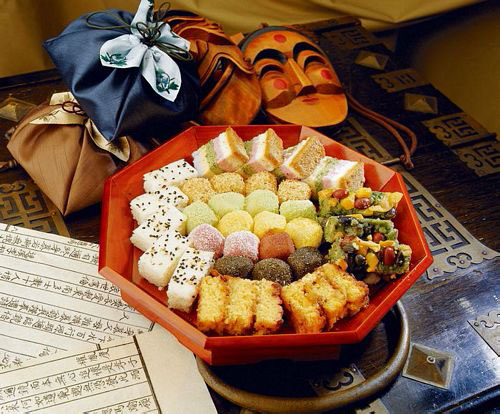
Korean Lunar New Year Dishes
The Korean Lunar New Year, known as Seollal, is celebrated by feasting on traditional dishes that hold special significance. Here are some of the must-try dishes:
Tteokguk
Tteokguk, or Korean rice cake soup, is a staple dish that represents new beginnings. Its sliced, round rice cakes make up the primary part of the dish. Beef brisket, egg, seaweed, and green onions are added to complement the homemade beef broth. Tteokguk is traditionally served as a breakfast dish to start off the New Year with a positive note.
Mandu
Mandu, or Korean dumplings, are handmade and commonly filled with a mixture of vegetables and ground meat. The vegetable portion consists of chopped onions, cabbage, and mung bean sprouts. Mandu is said to symbolize good luck and goodwill for loved ones. These dumplings can be pan-fried or steamed and served as an appetizer or side dish. They can also be added to tteokguk soup to make tteok mandu guk, another popular New Year's dish.
Japchae
Japchae is a stir-fry noodle dish made with sweet potato glass noodles and mixed with various vegetables. It is commonly served as a side dish and pays homage to Korean heritage. This colorful dish can also be served as a main dish with meat and rice.
Hobak Jeon
Hobak Jeon, or fried zucchini, is a celebratory dish that is perfect for balancing out rich flavors. The zucchini slices are breaded and fried in oil, making for a simple yet delicious side dish.
Sanjeok
Sanjeok is Korea's take on meat skewers, using thinly sliced beef, carrots, and green onions. Imitation crab meat or pickled radish can also be added for a pop of color. The mixture is covered in a thin layer of flour and egg, and then fried to create a harmonious blend of flavors.
Galbijjim
Galbijjim is a well-known Korean beef short rib stew that is slowly cooked in a mixture of tasty ingredients. The meat is coated in a marinade made of Asian pear, sea kelp stock, and brown sugar, making for a truly unique dish that carries the weight of Korean history.
Nokdujeon
Nokdujeon is a pancake made from ground-up mung beans, minced pork, and kimchi. The batter is made from soaking the beans, then blending them with water to create the base. Nokdujeon is considered ancestral rites food and is offered as a gesture to Korean ancestors.
Gujeolpan
Gujeolpan can literally be translated into "a plate with nine sections." It is a large platter filled with eight different side dishes arranged around a pile of thin, crepe-like pancakes. This dish is usually one of the more elaborate dishes, dating back to the 14th century, and represents distinct elements that rule over our universe. The dish can vary in components, but all five colors (red, yellow, white, black, and blue or green) should be represented.
Yaksik
Yaksik is a sweet rice dish made with honey, dried fruits, and nuts. This dessert has the medicinal benefit of honey and its name can be translated to "medicinal food." The rice used is sticky with a gluey texture, and any mix of dried fruits and nuts can be added to the mix along with sesame oil, honey, and soy sauce.
Sikhye
Sikhye is a traditional Korean sweet rice drink made from water, barley flour, sugar, and rice. It is fermented to give it a unique scent and contains floating rice grains to give it texture. While it can be found canned in Korean grocery stores, it is best made at home.
Bulgogi
Bulgogi, meaning "fire meat," is a classic Korean dish that can be served as a main or side dish. It is a marinade of soy sauce, sugar, sesame oil, and garlic and is usually made with beef, but can also be made with other meats such as pork or chicken. The meat is cooked until crispy and can be served on a bed of
Originally Post From https://www.tastingtable.com/1492978/what-dishes-lunar-new-year-korea/
Read more about this topic at
Seollal, Korean Lunar New Year
5 traditional desserts to eat during Seollal (Lunar New Year)


Social Plugin